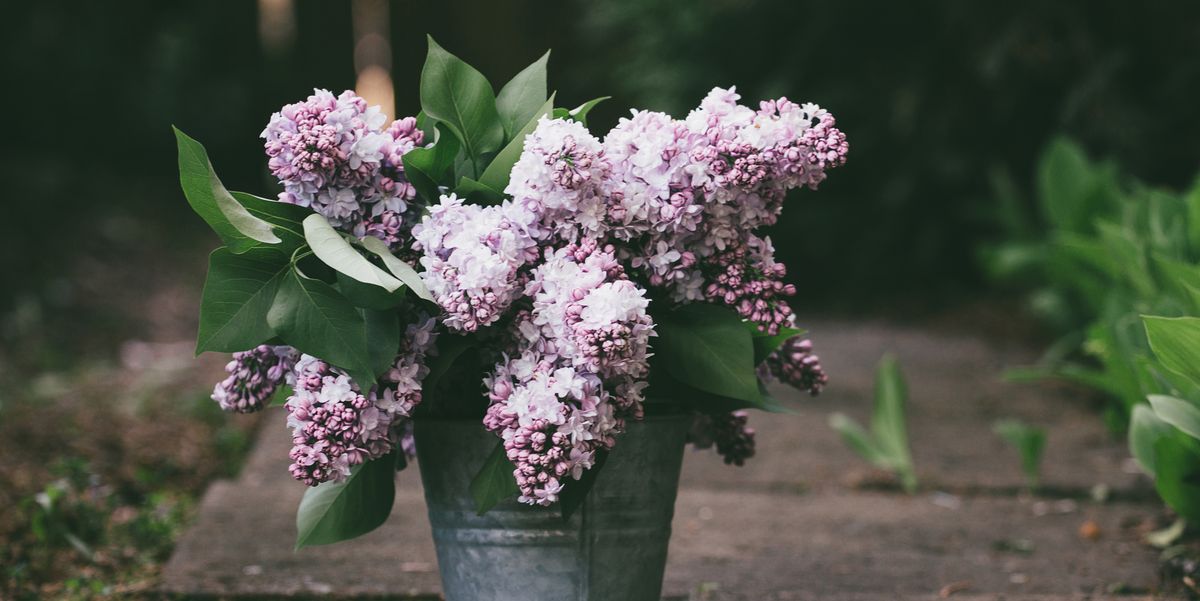Lilacs have been filling my Instagram feed lately—lilac bushes in full flower, bountiful bouquets of cut lilac stems in the arms of smiling gardeners, and lilac blooms piled high in baskets or gracefully spilling over the tops of mason jars and galvanized buckets.
So, with lilacs on the brain, I hit the Country Living archives where I found not only this very handy guide to growing lilac bushes, but also a trove of reader questions about these fragrant spring-flowering shrubs along with expert answers. Read on for all sorts of fascinating lilac know-how, whether you want to grow your own or are simply an admirer!
Will My Mom’s Lilacs Love Texas?
Question: My mom has a lilac bush she loves, but she is planning on moving from New York to Houston. Can lilacs grow in Texas, or should she just leave it behind?
Answer: Although we appreciate your mom wanting to transplant a sentimental favorite to her new home, we are afraid this probably won’t be a successful relocation. Most common lilacs (members of the Syringa vulgaris clan) require a considerable cold period during the winter and don’t do well south of Zone 7. Some cultivars can tolerate as far south as Zone 8, such as “Betsy Ross,” “Old Glory,” and “Miss Kim.” However, Houston is classified as Zone 9b on the current USDA Plant Hardiness Zone Map.
An idea? Instead of lilac, Lady Bird Johnson Wildflower Center suggests planting Texas mountain laurel (Sophora secundiflora), which is shrub native to the Texas Hill Country that offers fragrant, purple blooms in early spring. In Houston, make sure to plant it in a raised area with good drainage. (For more lilac alternatives for other areas, check with your local cooperative extension for suggestions.)
Tips for Pruning “Tree Size” Lilac Bushes
Question: We have a row of about 40 lilac bushes (including white, light purple, and dark purple; I do not know what type they are) that are in drastic need of pruning—they have not been touched in over 10 years! How do I prune these bushes—that are now tree size, actually?
Answer: Pruning lilacs is actually quite simple. Immediately after they bloom, remove about one third of the old, treelike trunks, cutting them to the ground. New shoots (called suckers) will then begin to emerge from the base of the shrub. Continue removing one third of the old growth each year until the bush reaches the proportions you desire. In severe cases, the pruning process can be done all at once, cutting the entire shrub to the ground; however, removing all the old growth simultaneously is very hard on the bush, and you won’t have any flowers for several years.
Troubleshooting a Lilac That’s Stopped Blooming
Question: I have a lilac bush that has quit blooming, and I’d like to know when is the best time to trim or prune it? It is about four feet high and has not bloomed in two or three years.
Answer: Usually when you do some hard pruning during a season, you will have plenty of new growth the next year—but the blooms are sacrificed for several years. If that is the case, then be patient and your lilac blooms will be back.
Lilacs can grow in light shade but bloom the best when they have plenty of full sun. If they are getting plenty of sun and you have not pruned them, try feeding them a bloom booster. You can also treat your shrub to a good mulch of well-rotted manure, since lilacs deplete soil of nutrients over time (they thrive in fertile soil).
To prune lilacs, you want to thin out unproductive growths where old bushes become overcrowded with too many branches and sucker stems. It is best to prune after flowering, but don’t forget to take advantage of the incredible fragrance by taking cuttings for your friends and family!
Is It Okay to Grow Lilacs in Planters? (Yes, But Not Forever)
Question: I just bought two young lilac bushes and was wondering if I could plant them in two big planters for about a year or so, or if it would kill them. Thanks for any help you can provide!
Answer: Yes, you can. Lilacs make okay container plants on a temporary basis (say, a season or two). In general though, their growth habit and large size negate their use in containers long term. Just be certain their final planting location has full sun and sufficient space, and be sure to emend the soil with lime each year for best bloom.
Rid Your Lilac of Mildew
Question: I recently planted a lilac from a root, and it is doing very well except I noticed a white, powdery substance on the leaves. Do you know what causes this?
Answer: The white, powdery substance is most likely a mold on the leaves called “powdery mildew” or “downy mildew.” Since it is a fungus, you’ll need to use a fungicide to kill it. Plants get this when conditions are moist and humid or after several days of rain. Also, being in shade will promote this mildew. When watering plants, aim for the roots and avoid getting the leaves wet.
My Lilacs Won’t Last
Question: I love lilacs, but when I cut them and bring them into the house they don’t last long before they wilt. I put them into tempered water that does not have chlorine. Is there anything else I can do?
Answer: Unfortunately lilacs are just one of those cut flowers you have to appreciate for their ephemerality. I’ve seen various suggestions about crushing the stems, adding preservatives or using warm water, but the fact of the matter is that blossoms still wilt quickly no matter what you do, usually within two days. Interestingly, white lilacs and some of the more modern, less scented cultivars seem to last far better than the common mauve type with the best fragrance. As with many things in this world, it seems you can’t have everything at once!








